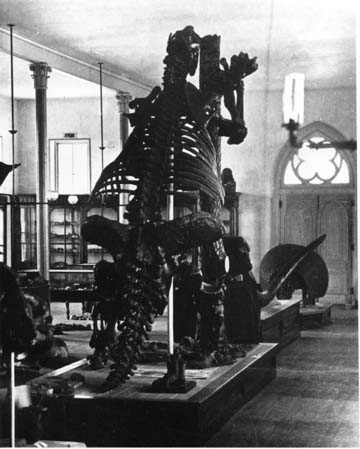David Dale Owen's Megalonyx
|
Megalonyx is the genus name given by Thomas Jefferson to a huge extinct sloth. The name means "great claw," and Jefferson introduced the species in one of the very earliest of all American paleontological publications.
David Dale Owen of New Harmony, Indiana, owned a Megalonyx jeffersonii skeleton. It was one of the most highly prized items in the Owen Museum —known in its day as the largest museum west of the Allegheny Mountains. The story of Owen's Megalonyx was printed in his own words in a publication of the Smithsonian Institution:
Joseph Leidy, A Memoir on the Extinct Sloth Tribe of North America, Smithsonian Contributions to Knowledge, 1855.
|

|
Leidy quotes Owen's letter, marked NEW HARMONY, INDIANA, September 18, 1854:
DEAR SIR: During my geological survey made this summer in Kentucky, I visited and examined the locality of the matrix of the bones of the Megalonyx, which form the collection I forwarded to you for description in the memoir...
Travellers on the Ohio river will, doubtless, have noticed a remarkable rising ground, from five to six miles below Henderson, on the Kentucky shore, elevated considerably above the adjacent bottom land; and forming the site of a beautiful country residence, belonging to Mr. Walter Alves. It is to that gentleman I am indebted for the above valuable collection of bones sent to me in the summer of 1850...
In the bank of the Ohio river, a few paces below the above-mentioned mound-like elevation, the bones in question were found, seventy feet below the ancient channel of Canoe creek, and eighty-five feet below the site of Mr. Alves's house on the above elevated point of land around which Canoe creek meandered. The bone-bed is only some five or six feet above the ordinary low stage of water, lying intermixed and partially imbedded in a ferruginous sand charged with Paludina ponderosa, Say, ...
Just beneath this ferruginous sand and shell bed, is a blue or rather a dark ash-colored clay. This clay has been most remarkably hollowed out into large cavities ("pot holes"). Into these cavities the ferruginous sand has been swept apparently by eddying currents of the Ohio river...
One thing...is very certain, both from the position of these bones and those found, under analogous circumstances, in the banks of the Ohio, below Evansville, Vanderburg [Vanderburgh] County, Indiana, that they are, comparatively speaking, of a very recent date...
Subsequent correspondence between Owen in New Harmony and Leidy in Philadelphia shows that Leidy was reluctant to return the bones. Owen wrote a brief letter on April 28, 1856. "I could not consent to dispose of my Megalonyx bones. My address is New Harmony, Posey Co., Inda..."
In 1992, my son Brian and I tried to find the location Owen describes. It was easy to find the mouth of Canoe Creek on land owned by The Nature Conservancy, but there was no trace of the elevated site of the former Walter Alves residence. In a letter dated Dec. 28, 1993, a great-grandson of Mr. Alves confirmed that long, long ago, "the Ohio River caved in more than 800 feet of the land which included the old home place."
In a letter dated Dec. 1, 1993, the Chief Curator of Natural History of the Indiana State Museum wrote that "the Henderson sloth was eventually mounted at Indiana University, Bloomington,...; the few remaining bones...are now reposited at the Indiana State Museum, Indianapolis.
Owen's reference to a very recent date applies also to the fossilized jawbone of the first known dire wolf (Canis dirus Leidy; see link below), found in 1854 in Evansville near the mouth of Pigeon Creek. In 1870, Leo Lesquereux took wood samples from the stratum containing the Megalonyx and dire wolf bones. An article published in 1958 states that these samples were radiocarbon-dated at an age of 9400 years. This age is accepted, with some reservation, as the terminal record for Megalonyx.
The megatherium shown here was a cast once in a museum at Indiana University. By comparing its size to the door in the photograph, you can get an idea of the enormity of Owen's Megalonyx. Image courtesy of Indiana University Archives (link below).
David Dale Owen, geologist
Dire Wolf
Indiana University Archives Homepage
New Harmony Scientists, Educators, Writers & Artists
Clark Kimberling Home Page
